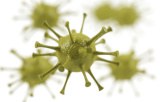
qPCR for virology and parasitology
Real-time quantitative PCR is used for the diagnosis of infectious diseases as well as sexually transmitted diseases caused by pathogenic microorganisms.
It is especially for the detection of pathogens that are difficult to cultivate, especially viruses, that PCR has become the reference method.
PCR detection is often opposed to the detection of antibodies. Molecular methods, like antigen detection, allow diagnosis in the acute phase of a disease, before the appearance of antibodies. The presence of antibodies in the serum is indeed measurable at the earliest after a few days (rubella, chickenpox), or even a few weeks (respiratory viruses, Lyme disease). In the acute phase, a positive PCR most often demonstrates an infection, whereas a negative serology must be repeated in a timely manner to demonstrate seroconversion.
Real-time quantitative PCR allows the genome of pathogenic organisms to be quantified and thus not only to detect and establish a diagnosis, but also to monitor the evolution and response to treatment.


